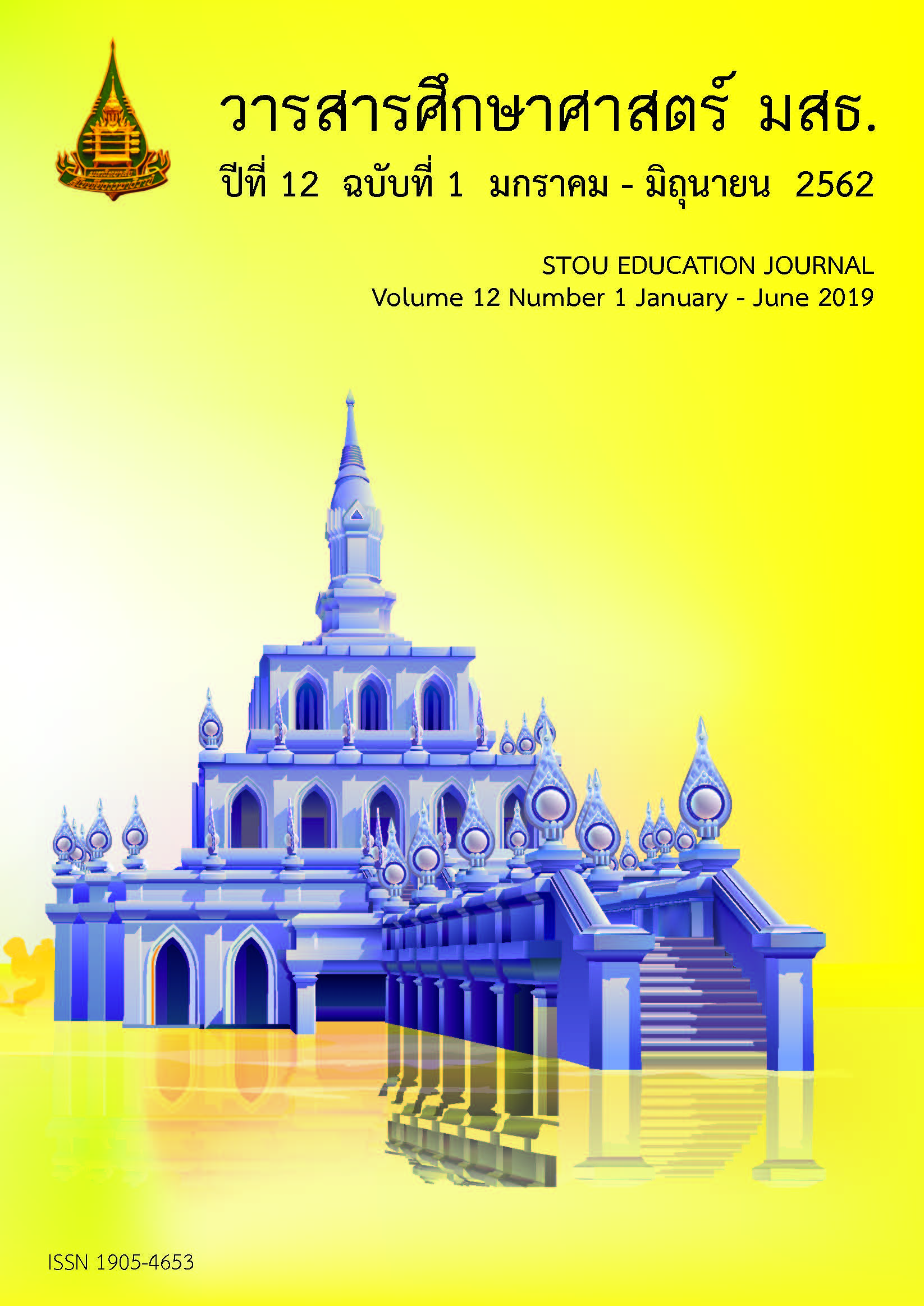มุมมองทฤษฎีระบบของรูปแบบการพัฒนาวิชาชีพครูสะเต็ม
Main Article Content
บทคัดย่อ
การวิจัยนี้มีจุดมุ่งหมายเพื่อศึกษาและสร้างรูปแบบการพัฒนาวิชาชีพครูในการรู้เรื่องสะเต็มของครูในระดับการศึกษาขั้นพื้นฐาน การดำเนินการเริ่มจากออกแบบและพัฒนาสื่อ และกิจกรรมการเรียนรู้สะเต็ม เพื่อชีวิต เศรษฐกิจและสังคม 11 กิจกรรม จากนั้นนำไปออกแบบและดำเนินการพัฒนาครูสะเต็มตามลักษณะสำคัญที่สังเคราะห์ขึ้น ประชากรเป็นครูในเขตจังหวัดเชียงใหม่ที่เข้าร่วมการพัฒนาวิชาชีพครูสะเต็มจำนวน 237 คน กลุ่มตัวอย่างได้มาจากการสุ่มแบบกลุ่ม จำนวน 40 คน ในจำนวนนี้มีผู้ให้ข้อมูลสำคัญ จำนวน 8 คนที่ได้มาโดยการเลือกแบบเจาะจงและอาสาสมัคร เครื่องมือที่ใช้ในการเก็บรวบรวมข้อมูล คือ (1) แบบสอบถามการรู้เรื่องสะเต็ม (2) แบบสัมภาษณ์รายกลุ่มแบบ Focus Group (3) แบบสังเกตกิจกรรม (4) เอกสารและชิ้นงานที่ครูสร้างขึ้น (5) การปฏิสัมพันธ์ของครูในเครือข่ายสังคมออนไลน์ (6) แบบตรวจสอบรายการลักษณะสำคัญ (7) แบบบันทึกการวิเคราะห์เนื้อหา และ (8) แบบสอบถามในการทำประชาพิจารณ์ ข้อมูลเชิงปริมาณวิเคราะห์การทดสอบค่าที และการวิเคราะห์ความแปรปรวน ข้อมูลเชิงคุณภาพวิเคราะห์ด้วยวิธีวิเคราะห์เนื้อหาและการเปรียบเทียบซ้ำ ผลการวิจัยพบว่า การพัฒนาวิชาชีพครูในระดับการศึกษาขั้นพื้นฐานให้มีการรู้เรื่องสะเต็มที่พัฒนาขึ้น รวมทั้งส่งเสริมความสามารถในการออกแบบและนำกิจกรรมสะเต็มไปใช้ในชั้นเรียน ภายใต้กรอบแนวคิดที่มุ่งเชื่อมโยงและพัฒนาบริบทชีวิต เศรษฐกิจและสังคมของผู้เรียน เป็นปรากฎการณ์ที่มีความซับซ้อน มีปัจจัยต่างๆ เกี่ยวข้องมาก ไม่สามารถมองปรากฎการณ์ในเชิงเหตุการณ์เชิงเดี่ยวได้ การใช้กรอบแนวคิดทฤษฎีระบบเพื่อนำเสนอรูปแบบการพัฒนาครูสะเต็มที่ประกอบด้วย ปัจจัยนำเข้า กระบวนการที่นำไปสู่การเปลี่ยนแปลง ผลผลิต ผลลัพธ์และผลกระทบ เป็นแนวทางสำคัญที่จะช่วยพัฒนาครูและขับเคลื่อนการจัดการเรียนรู้ตามแนวทางสะเต็มศึกษาอย่างเป็นระบบ โดยมุ่งผลลัพธ์ในการพัฒนาการจัดการเรียนรู้ของครูสะเต็มอย่างมีประสิทธิภาพ ที่จะส่งผลกระทบต่อผู้เรียนให้มีศักยภาพสะเต็มซึ่งเป็นเป้าหมายสำคัญของการจัดการศึกษาในปัจจุบัน
Article Details
เอกสารอ้างอิง
กระทรวงศึกษาธิการ. (2554). ประกาศกระทรวงศึกษาธิการ เรื่อง มาตรฐานคุณวุฒิระดับปริญญาตรี สาขาครุศาสตร์ และสาขาศึกษาศาสตร์ (หลักสูตร 5 ปี). เข้าถึงได้จาก http://www.mua.go.th/users/tqf-hed/news/FilesNews/FilesNews6/education5year_m1.pdf.
กระทรวงศึกษาธิการ. (2560ก). แผนการศึกษาแห่งชาติ พ.ศ. 2560 – 2579. กรุงเทพฯ: บริษัท พริกหวานกราฟฟิค.
กระทรวงศึกษาธิการ. (2560ข). แผนพัฒนาการศึกษาของกระทรวงศึกษาธิการ ฉบับที่ 12 (พ.ศ. 2560 - 2564). สำนักงานปลัดกระทรวงศึกษาธิการ เข้าถึงได้จาก http://www.moe.go.th/moe/th/news/detail.php?NewsID=47194&Key=news20.
ขจรศักดิ์ บัวระพันธ์. (2553). กระบวนการวิจัยเชิงคุณภาพ:เอกสารประกอบการประชุมปฏิบัติการวิเคราะห์ผลการใช้เครื่องมือนิเทศ ติดตามการจัดการเรียนการสอนคละชั้นในโรงเรียนขนาดเล็ก. กรุงเทพฯ.
คณะกรรมาธิการการสื่อสารมวลชน การวิทยาศาสตร์ เทคโนโลยีและสารสนเทศ. (2558). รายงานข้อเสนอเชิงนโยบายสะเต็มศึกษา (STEM Education) นโยบายเชิงรุกเพื่อพัฒนาเยาวชนและกําลังคนด้านวิทยาศาสตร์เทคโนโลยีวิศวกรรมศาสตร์และคณิตศาสตร์. เข้าถึงได้จาก http://library.senate.go.th /document/Ext11101/11101417_0003.PDF.
สุทธิดา จำรัส. (2560ก). การเรียนรู้ที่บูรณาการร่วมกับเทคโนโลยี. คณะศึกษาศาสตร์ มหาวิทยาลัยเชียงใหม่. กรุงเทพ: จรัญสนิทวงศ์ การพิมพ์.
____________. (2560ข). สะเต็มศึกษาบนเส้นทางวิชาการรับใช้สังคม: จุดเปลี่ยนการเรียนรู้สู่อนาคต. ศึกษาศาสตร์ปริทรรศน์, 31(3), 34-47.
____________. (2560ค). นิยามของสะเต็มและลักษณะสำคัญของกิจกรรมการเรียนรู้ตามแนวสะเต็มศึกษา. วารสารศึกษาศาสตร์ มสธ., 10(2), 13-34.
____________. (2562). การออกแบบและพัฒนาสื่อและกิจกรรมการเรียนรู้สะเต็มเพื่อชีวิต เศรษฐกิจ และสังคม. วารสารวิชาการ Veridian E-Journal บัณฑิตวิทยาลัย มหาวิทยาลัยศิลปากร, 12(2), 1150-1170.
สํานักงานคณะกรรมการพัฒนาการเศรษฐกิจและสังคมแห่งชาติ. (2560). แผนพัฒนาเศรษฐกิจและสังคมแห่งชาติฉบับที่ 12 (พ.ศ. 2560-2564). กรุงเทพฯ: สํานักนายกรัฐมนตรี.
สำนักงานเลขาธิการสภาการศึกษา. (2559). รายงานการวิจัยเพื่อจัดทำข้อเสนอนโยบายการส่งเสริมการจัดการศึกษา ด้านสะเต็มของประเทศไทย. กรุงเทพฯ: พริกหวานกราฟิก.
Ashton, P. T. (Ed.). (1990). Theme: Pedagogical content knowledge [Special issue]. Journal of Teacher Education, 41(3).
Association of American Universities. (2013). Framework for systemic change in undergraduate STEM teaching and learning. Retrieved from https://www.aau.edu/sites/default/ files/STEM Scholarship/AAU_ Framework.pdf.
Avery, Z. K., & Reeve, E. M. (2013). Developing effective STEM professional development programs. Journal of Technology Education, 25(1), 55-69.
Capraro, R. M., Capraro, M. M., & Morgan, J. R. (Eds.). (2013). STEM project-based learning: An intergrated science, technology, engineering, and mathematics (STEM) approach. Springer Science & Business Media.
Chen, D., & Stroup, W. (1993). General system theory: Toward a conceptual framework for science and technology education for all. Journal of Science Education and Technology, 2(3), 447-459.
De Miranda, M. A. (2008). Pedagogical content knowledge and engineering and technology teacher education: Issues for thought. Journal of the Japanese Society of Technology Education, 50 (1), 17-26.
Dyer, J. H., Gregersen, H. B., & Christensen, C. M. (2009). The innovator’s DNA. Harvard Business Review, 87(12), 60-67.
Faikhamta, C., Ketsing, J., Tanak, A., & Chamrat, S. (2018). Science teacher education in Thailand: a challenging journey. Asia-Pacific Science Education. Retrieved from https://doi.org/10.1186/s41029-018-0021-8.
Glaser, B., & Strauss, A. (1999). The discovery of grounded theory: Strategies for qualitative research. Chicago: Aldine Transaction.
Hammond, D. (2010). The science of synthesis: Exploring the social implications of general systems theory. University Press of Colorado.
Hattie, J.A.C. (2003). Teachers make a difference: What is the research evidence? Paper presented at the Building Teacher Quality: What does the research tell us ACER Research Conference, Melbourne, Australia. Retrieved from http://research.acer.edu.au/research_conference_2003/4/.
Hayford, B., Blomstrom, S., & Mumpower, L. A. (2015). Formation and assessment of a tool to evaluate STEM literacy in service-learning projects. Journal on Excellence in College Teaching, 26(4), 73.
Institute for the Promotion of Teaching Science and Technology (IPST) (2018). STEM education movement project fiscal year 2018. Retrieved from http:// pd.ipst.ac.th/?page_ id=2990.
Kast, F. E., & Rosenzweig, J. E. (1972). General systems theory: Applications for organization and management. Academy of Management Journal, 15(4), 447-465.
Ledbetter, M. L. S. (2012). Teacher preparation: One key to unlocking the gate to STEM literacy. CBE—Life Sciences Education, 11(3), 216-220.
Lederman, N., & Lederman, J. (2013). Is it STEM or “S & M” that we truly love? Journal of Science Teacher Education, 24(8), 1237-1240.
Mahoney, M. P. (2010). Students’ attitudes toward STEM: Development of an instrument for high school STEM-based programs. Retrieved from https://scholar.lib.vt.edu/ejournals/JOTS/v36/v36n1/mahoney.html.
Mobley, M. C. (2015). Development of the SETIS instrument to measure teachers’ self-efficacy to teach science in an integrated STEM framework. Doctoral Dissertation, University of Tennessee.
National Research Council. (2011). Successful K-12 STEM education: Identifying effective approaches in science, technology, engineering, and mathematics. Washington DC: National Academies Press.
Neuendorf, K. A. (2002). The content analysis guidebook. Thousand Oaks, CA: Sage.
Oliver, J. S., Jackson, D. F., Chun, S., Kemp, A., Tippins, D. J., Leonard, R., Kang, W.H., & Rascoe, B. (2001). The concept of scientific literacy: A view of the current debate as an outgrowth of the past two centuries. Electronic Journal of Literacy through Science, 1(1). Retrieved from http://sweeveyhall.sjsu.edu/ejlts.
Shulman, L. S. (1986). Those who understand: Knowledge growth in teaching. Educational Researcher, 15, 4-14.
Smith, M. K., Jones, F. H. M., Gilbert, S. L., & Wieman, C. E. (2013). The classroom observation protocol for undergraduate stem (COPUS): A new instrument to characterize university STEM classroom practices. CBE Life Sciences Education. Retrieved from https://doi.org/10.1187/cbe.13-08-0154.
Taber, K. S. (2017). The use of Cronbach’s alpha when developing and reporting research instruments in science education. Research in Science Education, 48(6), 1-24.
The Development Assistance Committee Working Party on Aid Evaluation. (2002). Glossary of key terms in evaluation and results based management. France: OECD Publications.
Von Bertalanffy, L. (1973). The meaning of general system theory. General system theory: Foundations, development, applications. New York: George Braziller.
Wang, H., Moore, T., Roehrig J., Gillian H., & Park., M. (2011) "STEM Integration: Teacher perceptions and practice, Journal of Pre-College Engineering Education Research (J-PEER), 1(2),2, [Online]. Available http://dx.doi.org/10.5703/ 1288284314636.
Williams, P. (2011). STEM Education: Proceed with caution. Design And Technology Education: An International Journal, 16(1), 26-35. Retrieved from https://ojs.lboro.ac.uk/DATE/article/view/1590.
Yoon, K. S., Duncan, T., Lee, S. W.-Y., Scarloss, B., & Shapley, K. (2007). Reviewing the evidence on how teacher professional development affects student achievement (Issues & Answers Report, REL 2007–No. 033). Washington, DC: U.S. Department of Education, Institute of Education Sciences, National Center for Education Evaluation and Regional Assistance, Regional Educational Laboratory Southwest. Retrieved from http://ies.ed.gov/ncee/edlabs.


